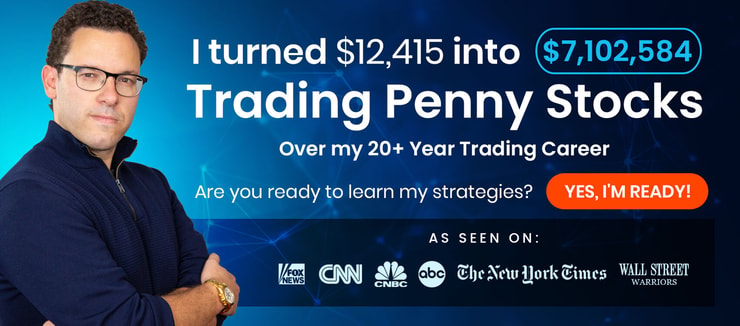Trading patience can be difficult — but it’s crucial.
When you first start trading, it’s exciting. You enter a trade … Your heart starts racing … It’s a rush, right? Depending on how the trade goes, that adrenaline rush turns into a sensation of pleasure or pain.
But that’s exactly why you must develop trading patience. And learn to take as much emotion out of trading as possible.
“Patience is bitter, but its fruit is sweet.” — Aristotle
What do I mean by trading patience? It’s not holding and hoping, I assure you. Keep reading for the answer.
But first, check out my…
Table of Contents
Arizona Adventures
I’m in Arizona meeting up with swing trader Paul Scolardi (aka the Superman of Stocks) and Roland Wolf.
Roland is my newest millionaire Trading Challenge student. He passed $1 million in trading profits earlier this year after starting with just $4,000 four years ago.* Roland has a new newsletter called “$1K Paydays” — watch the video there for more information.
(Quick note: all my millionaire students come from the Trading Challenge. If you’re serious about learning what it takes to trade for a living, apply today.)
My friendship with Paul goes back two decades. Paul is renowned for his smallcap swing trading strategy. If you’re interested in that strategy, check out his plans here. (For me, I’m too impatient for swing trading. Ironic since this post focuses on trading patience.)
(*These results are not typical. Individual results will vary. Most traders lose money. My top students have the benefit of many years of hard work and dedication. Trading is inherently risky. Always do your due diligence and never risk more than you can afford to lose.)
While in Arizona, I’m also getting in some hiking. Check it out…

2025 Millionaire Media, LLCThat’s me with my laptop on the Devil’s Bridge. I’m terrified of heights, so you can imagine how crazy it felt standing there.
Here’s another hike. (Notice I do all my own stunts…)
This was a pretty tough hike out here in #Arizona for me after I locked in a a solid $5k in trading profits earlier today. Never forget that it’s not enough just to make a lot of $ in life, you must look after your health too! #healthywealthyandwise #timjews pic.twitter.com/BPBrrNdZYs
— Timothy Sykes (@timothysykes) September 17, 2020
After six months of not traveling, I’m loving getting out again. But I’m also being very careful.
Now it’s time for…
Trading Mentor: Questions From Students
“On TCON you took a bigger position on the second trade when it dipped more. Would you have gone even bigger if it dropped another 10%?”
Correct. The bigger the panic, the better. There’s more potential for a bounce. I was a little early with TCON. I’ll break down the trades for you…
TRACON Pharmaceuticals, Inc (NASDAQ: TCON)
Tracon Pharmaceuticals announced the completion of a $5 million private placement in late August. As you can see on the six-month chart below, TCON has been running ever since.

TCON looked to be setting up for a nice panic dip buy. I said as much in this chat room comment just before it happened. Check it out…
09/15 9:59:28 AM: $TCON impressive strength, it’s gonna be a great dip buy one day this week into intraday panic.
I didn’t realize it was gonna happen so soon after my comment. Here’s the TCON intraday chart from September 15 with my two trades:

Again, I was a little early and cut losses quickly with the first trade. With the second trade, I took a bigger position size because the dip was bigger. It was a solid bounce. Playing it safe earlier allowed me to get my entry price much lower.
The first trade was a $300 loss but the second was a $2,090 win.*
The first trade is a great example of cutting losses quickly. The second trade is an example of trading patience. I didn’t try to force the trades. When I was wrong, I got out. When my favorite pattern played out better, I went bigger and won.*
A better bounce happened the next day. Take a look at the TCON five-day chart:

As you can see on the chart above, I was on the right track but early. Still, I played it safe and took the single. I traded TCON again on September 17 for another $2,574 profit.* You can see the details of that trade here.
I’m happy with how I traded TCON. Now I want to share my…
More Breaking News
- Sonnet BioTherapeutics: Analyzing the Recent Surge
- VOR’s Unexpected Surge: What’s Driving the Spike?
- Senate Proposals Threaten Sunrun as Solar Sector Faces Uncertainty
Trade of the Week
This is another great example of an informational inefficiency. And it’s also another huge testimonial for StocksToTrade Breaking News Chat. The Breaking News market pros are all over it!
Daily reminder of how incredible our world is/how you MUST stay positive and work your butt off to turn your dreams into reality. I’ve been hiking here in beautiful Arizona this week, but I still bring my laptop everywhere & I use @stockstotrade to find the best plays EVERY DAY! pic.twitter.com/nWX0d7hR7h
— Timothy Sykes (@timothysykes) September 18, 2020
(Quick disclaimer: I helped design and develop StocksToTrade.)
Diego Pellicer Worldwide, Inc. (OTCQB: DPWW)
Again, thanks to StocksToTrade Breaking News for alerting this SEC filing premarket. The SEC filing actually included the press release.
This is the alert given by the Breaking News team:
It was an ‘early bird catches the worm’ type situation. Check out the DPWW intraday chart from September 16…

Whew! As you can see from the chart, that was a fast trade. It spiked 70% in a few minutes. I managed a 45% win for $3,250 in profits* taking the meat of the move.
Notice when the press release happened. (I marked it on the chart.) I bought in anticipation of the news. This is what I love about penny stocks. You could actually read the news on the SEC filing before its release. Again, this is a classic example of penny stock informational inefficiency.
New to penny stocks? Get my FREE penny stock guide here.
No big company would ever put out an SEC filing with a press release and then take another hour or two to issue the PR. But because these companies are small, they’re inept. And they have inept teams. So you get these timing inefficiencies.
You could’ve bought anywhere near the market open. Or on the dip after the first spike. That was an amazing 60% bounce after the dip.
This is how I feel after a beautiful trade like that…

2025 Millionaire Media, LLCNow it’s time for the…
Trading Mindset Lesson: Trading Patience
You MUST develop trading patience.
A lot of people want to trade a lot — like they did in June, July, and August. But August was abnormally busy. September is slowing down a little, and you have to adapt. For me, I’m trading less. It’s not a crazy coincidence that I’m traveling in Arizona.
During the summer I wanted to stay home for the obvious reason: to stay safe. But it’s also true that there were so many plays. Now there are fewer plays, so it gives me the opportunity to visit Paul and Roland.
I wanted to visit them before, but I didn’t have the time. Now there’s time. As the market slows down, you can make more time for your life and family. You can trade a little less.
Remember, you can’t force trades. A lot of traders have this problem. They turn into degenerate gamblers. Then they overtrade their account deep into the loss column.
This is so important. Trading patience can mean the difference between profitability and blowing up your account. Avoid taking trades on non-ideal setups just for the sake of trading.
I teach students to start small and focus on the process. If you focus on how much money you can make, you short circuit your journey. Focus on being a better trader.
“The two most powerful warriors are patience and time.” — Leo Tolstoy
So no matter which strategy you use, trading is about patience and discipline. As a patient trader, you let your setup come to you. If you’re not sure which setup works best for you, then you’re in testing mode. And that’s OK. Just trade small until you figure it out. And most importantly…
Follow rule #1: cut losses quickly!
Millionaire Mentor Market Wrap
Be extra careful right now. Do yourself that favor. A lot of you think you need to force trades. Given what’s going on in the overall market, you need to protect, protect, protect! It’s a good opportunity to show trading patience.
We’re officially in the stock market crash season. I’m not trying to predict the market. But if you follow the weather, you know there’s a hurricane season. The end of September into October is stock market crash season.
The giant run-up we had includes the best 100 days in the stock market ever. I don’t know if we’ll have a crash, but everything is lining up…
- There’s election uncertainty.
- We’re still in the middle of a pandemic. (More uncertainty.)
- We just witnessed a huge stock market run-up.
- It’s stock market crash season.
- We’re seeing crash price action.
If it happens, be ready. Be more conservative with your trade plans. Cut losses quicker. Recognize the ability for the bottom to fall out on any trade.
If you get it, comment below with ‘I will be a patient trader.’ Let me know what you think of this post in the comments below. I love to hear from all my readers!












Leave a reply